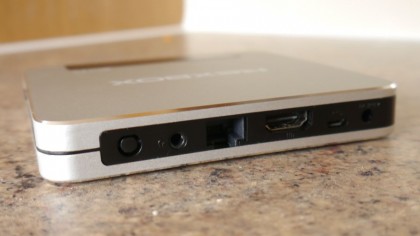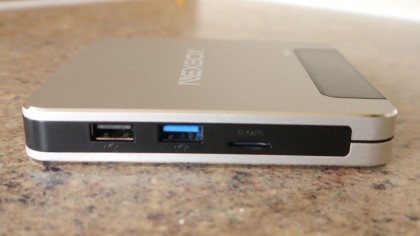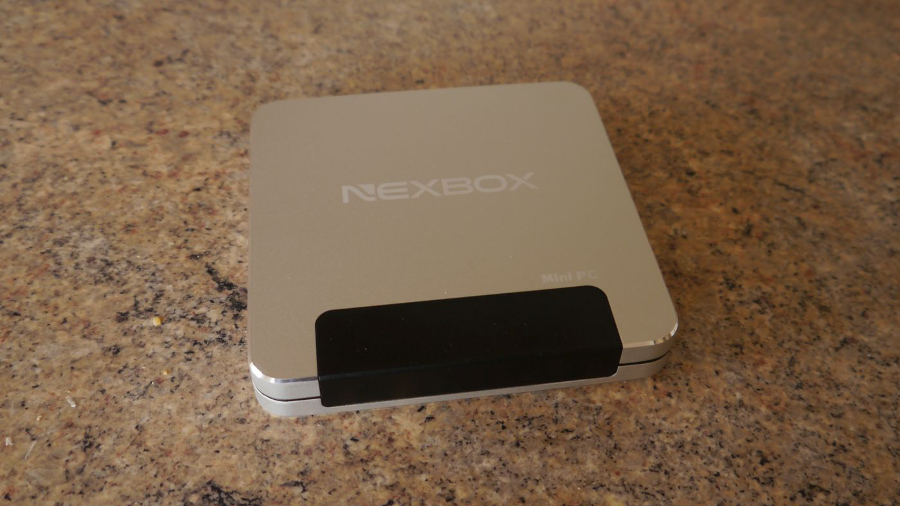Early Verdict
This is a great little TV box or mini PC which won't look out of place next to a monitor. But it's a shame about the pre-registered Windows fiasco – there's no need for that at all…
Pros
- +
Tiny
- +
Cheap
- +
Loads of ports
Cons
- -
No VESA mount option
- -
Pre-registered Windows 10
Why you can trust TechRadar
It's safe to say that the mini PC market is, well, very busy at the moment. There are dozens of models currently available with almost the same configuration and almost the same form factor.
And we've reviewed quite a few of them in the last few months (the Vorke V1, the Voyo V3, and the Beelink BT7 – the latter two are pictured with the T9 in the image below) but there are far more out there.
We called in the NexBox T9 to check out what the cheapest 4GB/64GB box on the market looks like. The product costs £92 ($116) at online retailer Gearbest but that's subject to exchange rate fluctuations.
The price includes delivery but excludes VAT and potential handling fees, which may add another 25%. The device is not available from eBay or Amazon at the time of writing. Before you commit to any purchase, it's well worth checking out our guide to buying tech from online Chinese retailers.

One thing that stunned us was how tiny this thing is – it's 115 x 115 x 15mm, which means that it should fit most jeans' back pockets. Being this size causes some inconveniences, however, as we shall see later.
First off, though, let's look at the design. This mini PC is almost entirely made of metal with ports on all but one side. There's a big NexBox logo on top and four rubber feet underneath. Ports include three USB 2.0, one USB 3.0, one micro-USB, one HDMI (full-size), an Ethernet port and a headphone socket. There's also a tiny blue light that shines when the device is powered on.

Interestingly, the PSU is barely larger than the ones that come with mobile phones and is a 5V/3A model (15W), which is a smidgen more than what you get with smartphones. In other words, expect the next generation of TV boxes to be powered by the same PSU as smartphones or tablets.
Sign up to the TechRadar Pro newsletter to get all the top news, opinion, features and guidance your business needs to succeed!
At its heart is the Intel x5-Z8300, a Cherry Trail-based quad-core processor. Its base frequency is 10% slower than the x7-Z8700 that can be found in all the other more expensive mini PCs mentioned above.
It also has a much slower burst frequency (1.84GHz vs 2.4GHz), supports one memory channel (rather than two), and has slower Intel HD graphics with 25% fewer execution units. The rest (TDP, core count, thread count and cache) remains the same.

We'd certainly have preferred it if Nexbox opted for the Z8700 rather than the Z8300. After all, the price difference between the two is only around a tenner. Intel says that the processor supports only 2GB of RAM and cannot do 4K video: Gearbest's description of the device says otherwise.
The low clock speed means that there is no fan. As such the unit is entirely silent and boasts a rather large heatsink to dissipate heat (plus there's always the chassis) – some additional air vents would be welcome but the absence of holes means that this box can be used in dusty environments. Wireless connectivity consists of 802.11n Wi-Fi and Bluetooth 4.0.
The unit definitely comes with 4GB of RAM, soldered onto the motherboard, and it also does 4K via the HDMI port, although at 30Hz. As with the rest of the competition, you get 64GB of eMMC storage and a microSD card slot should you want to beef that up.
Taking the device apart requires you to remove four screws (located under the rubber feet) but other than the MAC address, there's nothing much you will find inside as everything is soldered on the motherboard.

Note that the T9 doesn't come with a VESA mount probably due to its diminutive size, and possibly also to cut down on costs.
Windows 10 is already activated and like the Voyo products it does not require you to go through the usual installation process. Which is not something we were expecting or advocating. Indeed, we're puzzled by the fact that vendors decided unilaterally to implement this process rather than leaving the user to decide. There is absolutely no reason why this should happen.
Performance was generally what you'd expect from such a device. Great for mundane tasks but start pushing a little bit beyond its comfort zone and you notice the stutters. Basic office tasks are fine, but if you're web browsing with 20 tabs or more you will feel the pain.
Early verdict
We like the NexBox T9. It is small, has plenty of ports and the CPU downgrade compared to rivals (Z8700 to Z8300) didn't appear to do much harm to performance. It is also silent (although the downside is that it warms up a tad) and cheaper than the competition.
The usual caveats apply when buying products from China. What we do not understand, though, is why the vendor believed it was a good idea to pre-register the operating system.
Not only does that look suspicious to the end-user (including ourselves), it also makes it more tedious and long-winded to amend afterwards.
There are plenty of opportunities that the small size of the T9 offers both for businesses and for consumers alike.
Getting it to work with a digital signage solution or as a thin client should be easy enough. Its low power consumption means that it can be driven by a power bank or an external battery (similar to an uninterruptible power supply) and work as an autonomous computing unit.

Désiré has been musing and writing about technology during a career spanning four decades. He dabbled in website builders and web hosting when DHTML and frames were in vogue and started narrating about the impact of technology on society just before the start of the Y2K hysteria at the turn of the last millennium.
What is a hands on review?
Hands on reviews' are a journalist's first impressions of a piece of kit based on spending some time with it. It may be just a few moments, or a few hours. The important thing is we have been able to play with it ourselves and can give you some sense of what it's like to use, even if it's only an embryonic view. For more information, see TechRadar's Reviews Guarantee.
